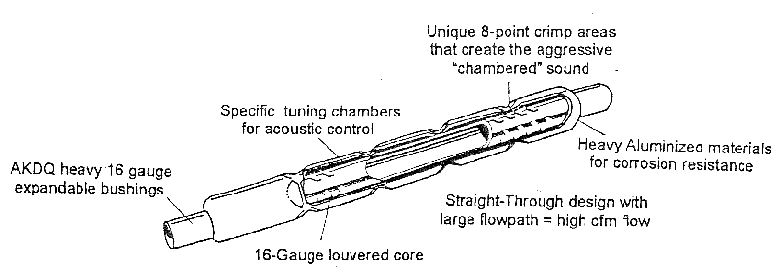|
|
CHAMBERED EXHAUST (THE MYSTIQUE):
WHAT IS CHAMBERED EXHAUST?
Early OEM chambered exhaust systems appeared on various GM musclecars back in the 1960's. Sidepipe-equipped Corvettes used them, and chambered exhaust was available as an option on '69 Z-28 Camaros, & '69 Chevelle SS & big block Camaros. Olds 442's also incorporated a chambered section in the tailpipes after the oval mufflers for additional sound tuning & noise reduction. Chrysler had originally planned to utilize chambered exhaust on AAR Cudas & T/A Challengers - but for whatever reason, the finished products ended-up with a very restrictive (175 cfm per muffler) side exit exhaust with oval mufflers.
Basically, a chambered exhaust muffler looked like a swollen section of pipe with "dents" in it. Inside the muffler, was a louvered core or flow tube, which reduced in diameter & restricted flow because of squeezing down the size of the path - this was a negative. As exhaust passed through this section, sound waves escaped the flow path & into the outer cavity - this is where the "dents" or "crimps" performed their magic! A unique turbulence was created in the sound waves, uninhibited by any packing material (there's no fiberglass or packing to burn-out). The crimps textured or "tuned" the sound in a way unlike other more conventional mufflers or glasspacks - vehicles running chambered exhaust had a sound all their own! Glasspacks contain packing material which absorb sound, & they generally produce a smooth tone. They also very often have a smaller diameter flowpath than the entry/exit of the muffler - this affects cfm flow capabilities negatively. A smaller flowpath also produces a quieter exhaust note.
FAQ's (Frequently Asked Questions):
- Can POWERSTICKS be installed several in a row? Yes, they have minimal backpressure. The longer they are, or several installed per bank, the more sound tuning & noise reduction you will accomplish.
- How are they constructed - what materials? Both the outer shell & internal flow tube are a heavy 16 gauge steel. The outer shell is aluminized for corrosion resistance. Other chambered exhaust has traditionally been constructed out of lighter materials - flow tubes being 18 gauge.
- Are they available in stainless? Not at this point - this could change if demand warrants it.
- Can they be used as primary mufflers? Absolutely! They sound best if used by themselves.
- Can they be used as resonators? Yes, they work fine as resonators located either before or after the main muffler(s).
- Will they burn out? No - they contain no packing material.
- Are they available in different sizes? Yes. POWERSTICKS are available in 2", 2-1/4", 2-1/2", & 3" in/out families. Each size family is available in three different lengths.
- Can POWERSTICKS be welded or clamped into a system? Both - they have straight bushings (stubs) which OD pipes slip inside of.
- How do they fit into my existing system? This is what there are exhaust shops for. There will usually be some degree of fabricating involved (pipe bending, cutting & welding, etc.) - this is why you will need an exhaust pro. A good exhaust technician can custom-bend an entire system for your vehicle & incorporate POWERSTICKS as your mufflers. Chambered exhaust is not just for GM vehicles!
- Is this something I can use on a late-model vehicle that has catalytic converters? You bet! Chambered exhaust will really wake-up the exhaust note on any late-model V-8. Some OBD1 & OBD2 vehicles even run multiple converters on each bank which can really rob some sweet engine exhaust sound, as well as produce unwanted exhaust backpressure. *Be sure not to modify the exhaust upstream of O2 sensors or converters - that is illegal.
- POWERSTICKS are "improved" vs.other chambered designs - how so? First of all, they maintain a true flowpath diameter - they flow more cfm. The entry of mufflers are sized ID, exhaust pipe is sized OD - this is why muffler entries/exits always fit over the pipe & then clamp. A 2-1/2" POWERSTICK is 2-1/2" ID at the entry/exit, while the flowpath is 2-1/2" OD - so it does neck down slightly. An old Thrush Turbo Tube that was sized 2-1/2" had a 1-7/8" ID flowpath. POWERSTICKS are fully constructed out of heavy 16-gauge materials - including the flow tube. POWERSTICKS do not "backrap", "cackle", or "pop" like other chambered exhaust - even on deceleration.
- What do they sound like on a V-10, or 6 or 4 cylinder motor? So far great results on mid-90's Toyota Celica Turbo cars with custom 3" exhaust. You'll have to be the judge on these.
- Are these emissions legal? Mufflers have nothing to do with controlling vehicle emissions, & they are not supposed to or required to. They purely control sound.
- Are POWERSTICKS street legal? Is a high-flow air filter? Depending on what they are installed on, & how, they may very well exceed "acceptable" sound levels in your area. A "legal" sound level is in most cases determined by the law enforcement officer while he has you pulled over, & "too loud" is generally purely subjective. When was the last time you heard of someone riding a Harley getting a ticket for excessive noise? You determine what is too loud - we'll just make the mufflers!
- What can I do if one POWERSTICK is too loud? You could either add a second one, use a longer one, or add a short glasspack to act as a resonator to soften the sound. *We may start carrying short glasspacks for resonators if there is a demand for them.
|



